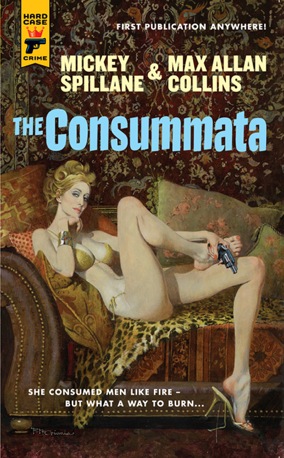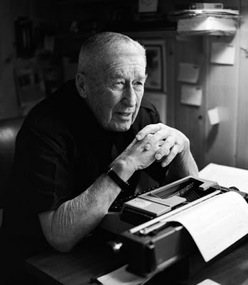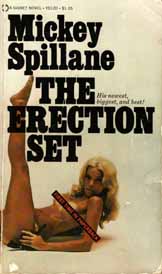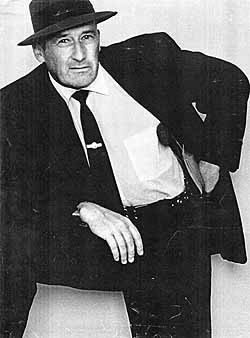 By the time you finish reading this, Max Allan Collins will likely have completed a novel, dashed off a novelization, and put the finishing touches on a graphic novel. But his prolific output–did I mention that he’s a sometime filmmaker?–isn’t what’s amazing about him. What is is that it’s all good. (I haven’t heard the band he’s in, but I wouldn’t write them off.)
By the time you finish reading this, Max Allan Collins will likely have completed a novel, dashed off a novelization, and put the finishing touches on a graphic novel. But his prolific output–did I mention that he’s a sometime filmmaker?–isn’t what’s amazing about him. What is is that it’s all good. (I haven’t heard the band he’s in, but I wouldn’t write them off.)
The pride of Muscatine, IA, a base of operations far from NY or LA, Collins has been grinding out pulp for decades. Pulp fiction, that is, in every form imaginable, including comic strips and trading cards. You’ve seen his name in lights, as the author of Road to Perdition, the basis for the acclaimed film hit. And he does run with the Hollywood crowd, if only as one of the more prominent scribes of movie novelizations. But mostly he works in the dark, toiling on tough guy thrillers featuring (among others) Chicago P.I. Nathan Heller and the hit man Quarry. There was also a Return to Perdition, published earlier this year.
Collins’ friendship with the king of hardboiled detective fiction, Mickey Spillane, has led to an unusual partnership since the creator of Mike Hammer died in 2006. Over time Spillane more or less bequeathed Collins, a friend and occasional collaborator since the 80s, his unfinished work, and Collins has been dusting off the pages ever since. First, it was Hammer time, as Collins completed three new novels featuring the infamous shamus. More are to come. But Collins has just sprung another Spillane character, Morgan the Raider, from cold storage.
A modern-day buccaneer, Morgan was introduced in The Delta Factor, then dropped when a film version flopped. In The Consummata, Morgan returns, up to his gun sights in espionage involving Cuban exiles, the CIA, and $40 million in stolen loot. Doublecrosses and corpses abound as Morgan zeroes in on the woman at the center of the web–the elusive “Consummata,” the world’s top dominatrix. “They were closing in,” the book begins, and it’s off and running.
I e-mailed Collins about Spillane, The Consummata, and other matters of intrigue. He shot me. Shot me back a few answers, that is.
 How did this particular project come to be? (I take that it has its roots in a soured film version of The Delta Factor in 1970.)
How did this particular project come to be? (I take that it has its roots in a soured film version of The Delta Factor in 1970.)
Mickey Spillane had an unusual number of substantial unfinished manuscripts in his files. There were various reasons why–chiefly his on again/off again relationship with his conservative church, who disapproved of his writing (but not his financial contributions). Also, he had a tendency to set manuscripts aside, intending to get back to them, when another enthusiasm took hold. He was a force of nature that way.
The Consummata was set aside, as you indicate, because of Mickey’s frustration with the film version of The Delta Factor. He had conceived his modern-day pirate, Morgan the Raider, as his next big series character, but the film did sour it. He’d been a producer on it, so in addition to being dissatisfied with the end result, he lost money on the deal.
Shortly before his death, he said to his wife Jane, ”After I’m gone, there will be a treasure hunt around here.” Mickey had three offices at his South Carolina home, one downstairs, one on his third floor, and another just outside, on stilts. ”Give everything to Max and he’ll know what to do.”
Obviously this was a great honor, but I admit I saw it coming. He had sent two partial Hammer manuscripts home with me in the late 80s, when we were collaborating on a lot of projects–anthologies and a comic book series–and also the unfinished Consumatta, about which he said, “Maybe someday we can do something with this.”
After the treasure hunt, we had a total of six substantial Hammer novel manuscripts, and I’ve just finished the fourth, actually, Lady, Go Die!, which Titan will bring out next May. There were two non-Hammer novels, Dead Street–which was more nearly finished–and The Consummata. Mickey and Charles Ardai had already been talking about Hard Case publishing something of his, so Hard Case was the obvious place to go. And of course I already had a strong relationship with Hard Case, who just published my Quarry’s Ex.
 How did you write in Spillane’s distinctive voice, and how does writing for Morgan differ from writing for Hammer?
How did you write in Spillane’s distinctive voice, and how does writing for Morgan differ from writing for Hammer?
Mickey’s protagonists are all different shades of the same guy, hardly unusual in the hardboiled mystery field. What I work hard to do is find and maintain Mickey’s voice in the period during which he wrote the unfinished material I’m working with. For The Consummata, obviously, I looked very hard at The Delta Factor, reading it again and again, using a marker pen like a college kid prepping for an exam. I looked at other mid-60s Spillane material, as well.
With Lady Go, Die! I was dealing with a very early manuscript–the second Mike Hammer, begun in 1945, over twenty years before The Consummata–and that was a much different Spillane/Hammer voice, and a younger, brasher version of the character. For that book I read and read and marked up the first several Hammer novels–I, the Jury, My Gun Is Quick and The Twisted Thing, the latter a book written around 1948 but not published till the mid-60s.
Did you find yourself shaping the manuscript your way, or adhering to Spillane’s vision as much as possible?
I stick to Spillane as much as possible and do my plotting in a manner that I believe reflects his approach. Sometimes I have plot and character notes, and about half the time I’ve had Mickey’s ending, either an actual draft or just a strong ending he had shared with me when we discussed various of these stories. Other times–and The Consummata was one–I don’t have anything but that substantial fragment, in this case around 100 pages. But that’s a good chunk and it gives me the entire cast of characters and the direction of the narrative. I am confident that I know Mick and his work well enough to predict where he was headed, and who the bad guy–or gal–is.
By the same token the book is (delightfully) ”incorrect” regarding sex and violence. Obviously you decided to maintain that, but did an ”inner censor” ever kick in as you were working with the manuscript?
No censor, inner or outer. This is pure and unadulterated Spillane, and Collins for that matter. I don’t share Mickey’s conservative politics, but the main character obviously does, and like any good actor, I stay in character. I grew up on great pulp. It’s in my bloodstream.
 Page 159 really took me back to the days when I would sneak ”adult” novels off my parents’ bookshelf. Hot stuff, late 60s style; was that something you had to add to or was that pretty much Spillane’s?
Page 159 really took me back to the days when I would sneak ”adult” novels off my parents’ bookshelf. Hot stuff, late 60s style; was that something you had to add to or was that pretty much Spillane’s?
Some of the sex stuff is by Mickey, but the really steamy one, the shower scene, is mine, very much working in his style of that period. If you check out my Nathan Heller novels, like the current Bye Bye, Baby, you will find the influence of my Spillane schooling. There’s no formula, but I make sure in most of my own novels–the Nate Heller and Quarry ones particularly–that there are shocking scenes of sex and violence. You can’t make spaghetti without marinara sauce. Well, I guess you can use alfredo sauce, if you’re dull.
The Nate Heller novels, incidentally, are all back in print from AmazonEncore in lovely trade paperbacks. They released the first book, True Detective, which won the Best Novel ”Shamus” Award from the Private Eye Writers of America in 1984, last week. It hit #1 on the Kindle bestseller list, I’m pleased to say. And Bye Bye, Baby is the first Heller in almost a decade, out from Forge and also doing nicely.
 Is there a particular anecdote that captures your relationship with Spillane?
Is there a particular anecdote that captures your relationship with Spillane?
We were friends. It was warm relationship, sort of a father-and-son relationship, but a mix where he treated me as an equal. He didn’t have any other writers in his life, really, during his last several decades. In the 50s, he used to hang around with a group of guys, some of them from the comic book field, who were also writers. But I was the only guy, in those last decades, he could talk shop with. Talk storytelling.
There are so many great stories, some having to do with my son Nate–Mickey was his godfather, and they were just two big kids together, fun to see Nate about eight and Mickey in his seventies just fooling around together, very grandfather and grandkid.
But I like this story. I was visiting Mickey around 1982, coming down from my home in Iowa (where I still live), and he was driving around in his ”Carolina Cadillac,” as he called it, a pick-up truck. We were outside a Hardee’s, having just put away some biscuits and gravy, and Mickey turned to me and said, ”What’s this I’m reading where you’re saying you want to be your generation’s Mickey Spillane?” And I said, ”Well, Mickey, I just mean, I would like to be the mystery reader of my generation who has your kind of impact and success.” This he barely seemed to hear, before saying, ”You can’t be your generation’s Mickey Spillane. I’m your generation’s Mickey Spillane.”
I like your Mommy films, and it looks as if Hollywood is coming to call you again with an adaptation of Black Hats. Have you tried to get a Spillane film off the ground?
Thanks for the kind words about my indie films. Did you know that a new cut of my 1999 documentary, Mike Hammer’s Mickey Spillane, is a special feature on the recent Criterion Collection DVD and Blu-ray of Kiss Me Deadly? Very proud of that. Mickey hated the film version of Kiss Me Deadly for years until I finally convinced him of its worth. He came to think Ralph Meeker was the best screen Mike Hammer, next to himself, of course. (Spillane, who’s in the Mommy films, was that rare author to play his own fictional creation, in the 1963 film The Girl Hunters–RC.)
There’s been a lot of Hollywood activity on Hammer, and some interest in other Spillane properties, too. After about a year where a Hammer TV show seemed about to happen, the emphasis has shifted to a film, which I think is exciting. There’s a possibility one of the Spillane/Collins will be the basis for a film.
I’ve also had the fun of working with Stacy Keach on two audio projects based on Spillane material, The New Adventures of Mike Hammer: The Little Death, which won an Audie for Best Original Work, and this year’s The New Adventures of Mike Hammer: Encore for Murder. These are two-and-a-half hour, full-cast ”movies for the mind.”
Speaking of movies, when you write a tie-in book, how closely does it adhere the finished film? (I imagine that the manuscript may have to be turned in before the movie is fully edited.)
When I base a novel on a screenplay, I am slavishly faithful to the structure, to the order of events and the characterization and every element of storytelling. But I do my best to craft a novel that seems to be the novel the film was based on, doing back story and expanding dialogue and adding scenes. Occasionally a studio hamstrings me, but usually I’m given my head. Saving Private Ryan and American Gangster, for example, are strong novels despite their filmscript roots. And I’ve occasionally turned a not-so-wonderful screenplay, like Daylight or I Love Trouble, into a really decent novel. I get some flack for doing work like this, but I’m a blue-collar writer, just keeping the food on the table and the lights on in the house. I’ve had some big successes, notably Road to Perdition, but I am a fulltime freelancer writer making my way in the world. Like my hitman Quarry, I’m for hire.
 Is there more Spillane in your future? (And, if so, please retain Robert McGinnis for the cover art; great job.)
Is there more Spillane in your future? (And, if so, please retain Robert McGinnis for the cover art; great job.)
All six of the substantial Hammer manuscripts will be completed. The first three were done at Harcourt for Otto Penzler, the next are being done at Titan. I have several other non-Hammer novels that may wind up at Hard Case, and I’m also fashioning short stories out of the less substantial fragments. A Hammer story that appeared in the Strand magazine, ”A Long Time Dead,” has been nominated for the Shamus and the Thriller awards and selected for a best of the year anthology. I hope to do enough short stories for a Hammer collection.
Funny thing about McGinnis. Initially Hard Case just wanted to reprint my 70s stuff, starting with Two for the Money, which collects the first two novels in my Nolan series. But Charles started asking for a new novel, specifically a Quarry. Quarry was the first hitman to star in a book series, and I’d written about him in the mid-70s, four novels that achieved a sort of cult status. So I kiddingly said to Charles, ”Get me Robert McGinnis for the cover, and I’ll do it.” Within days Charles called and said Bob McGinnis had signed on, and so The Last Quarry was written.
Incidentally, that novel was in fact intended to be the last Quarry novel, but it unexpectedly did so well with readers and reviewers that I came back with a prequel called The First Quarry. And I’ve done Quarry in the Middle and now Quarry’s Ex. The 2008 Quarry movie The Last Lullaby starring Tom Sizemore, which I co-wrote, is just out on DVD now. It’s a good little indie noir that got a lot of film festival love.
”Death can be so goddamned undignified. The saving grace is, when you’re dead, you don’t really give much of a shit.” Your philosophy or Spillane’s?
Not to be coy, but the way I work—which is to expand and extend Spillane, revise and polish and interweave my own stuff, as opposed to just plopping down his section and picking up where he left off–makes it difficult for me to remember who wrote what. I think that’s my line, however, though it’s certainly consistent with Mickey’s world view.





Comments